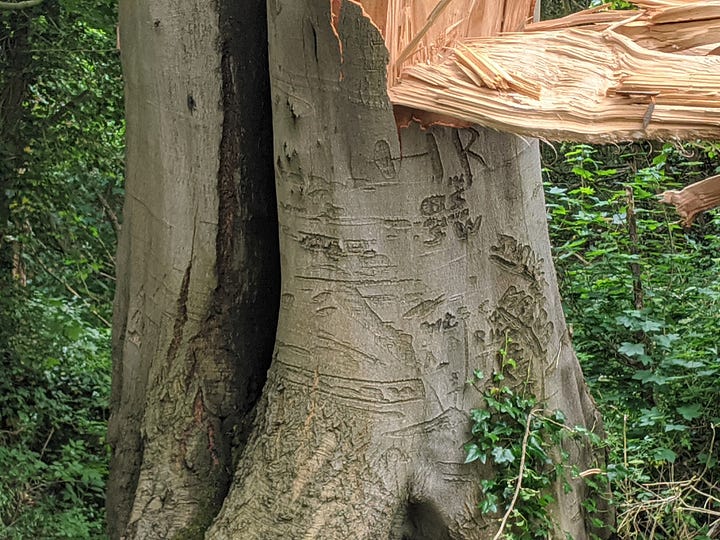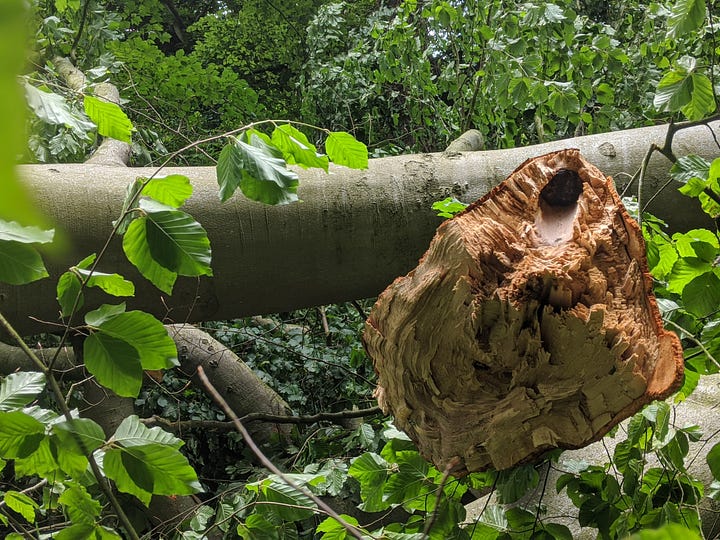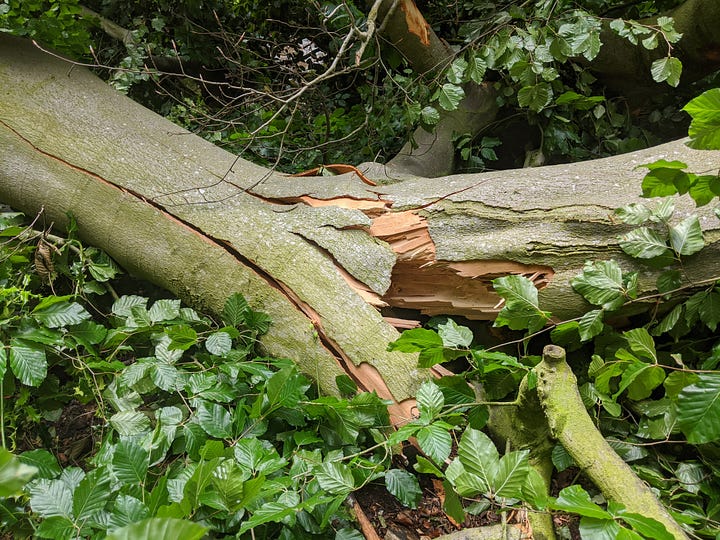Seventeen years ago this week I discovered that the couple I had bought Bluebell Cottage from had not been exaggerating when they said, ‘The woods are absolutely carpeted with bluebells, a sea of blue from one side to the other.’
When we collected the keys, on a brittle February day, that seemed most unlikely. The two acre woods were bare and bleak, with not the slightest hint of green anywhere. Barely two months later we stood on the newly cleared path, in quiet awe at the beauty of the spectacle in front of us.
Each spring since, we have walked through these woods enthralled by the loveliness of it, and also the timelessness. These woods - our woods by deed, but of course we are merely temporary custodians - are hundreds of years old. Pockets of them are dotted throughout the north west, mostly along stream banks, as ours is, on land which is too steep or too wet to have been cleared for agriculture.
The bluebells time their show to perfection, throwing up leaves to capture the light while the trees are bare and flowering in the last light before the canopy closes over them for the summer. By then the leaves have done their job and wither away, the seeds set and fall and the bulbs settle into dormancy in the dense shade of the summer woods.
We have always left fallen trees to slowly sink into the leaf litter, returning gently to the earth from which they came. Mostly trees reach the end of their life and fall of their own accord, but sometimes we cut down one that is clearly dead or dying and a risk to anyone who might walk underneath. It’s a wonderfully mixed woodland with hornbeam, cherry, beech, sycamore, oak, ash and lime vying for height. Below them, young elm suckers and elder do their best to fight their way up too, together creating a continuous canopy of greens. A bird could hop from one end to the other without bothering to fly.
Dominating the oldest part of the woods was a beautiful pair of beech trees, two seedlings that grew up side by side, entwined, like siamese twins. The left one had a branch wrapped around the other - you can see it about three-quarters of the way up. Our tree surgeon guessed they are - were - roughly 150 years old.
In April 2020 a long split appeared in the right hand one - I could clearly hear it creaking in the wind and kept a respectful distance. You can see the crack about 6 feet up on the picture below, next to its sibling. By May 2020 the crack was wide enough for a brave tree creeper to nest in.
In a normal year, the risk of this tree falling would have meant closing the woods to visitors, but you might have spotted that this all takes place in spring 2020, during the first pandemic lockdown. The woods were closed anyway - ours were the only footsteps that troubled it in that quiet, long, dry spring. I must admit, we loved the tranquility of it.
The weather broke in June with an almighty storm. My phone pinged at around 4.30 am, pulling me from a half-sleep as rain smacked the window. It was Ben Ranyard who was on his canal boat next to the woods. All I could make out was a string of expletives and the sound of rain slapping on his coat. The tree had fallen in the night, its crown landing about ten metres from Ben’s boat. The sound, like an explosion, had woken him (and Flash). An hour later we stood in the weak light of a glittering, wet dawn, awestruck at the sight of the fallen tree hanging precariously over the stream. brutally torn off at the base.
It’s impossible for a photograph to convey the scale, the overwhelming power of the scene. Each evening we went back to the woods with a rising sense of awe and mourning at the fallen tree. Its entangled, broken limbs brought to mind a fallen beast; a brontosaurus or a bull elephant, the smooth, wet trunk more like skin than bark.




In its fall, it had ripped off the branch from its sister tree that had been wrapped round it, leaving the other wounded and bereft. It has no branches on the side where its sibling once lived.
The change in the light level was obvious from the start. The lost tree has left an enormous hole in the tree canopy above, with no obvious contenders to replace it. Two smaller trees had been almost completely crushed by its fall, leaving a couple of damaged saplings, each no more than four or five feet high.
A year later, a large bramble patch appeared next to the fallen trunk. We frowned at it, considered what best to do and decided to strim it down, mostly to encourage a young oak sapling to grow.
That turned out to be merely a portent of what was to come. Under the open hole in the canopy thickets of brambles have leapt up everywhere, clambering over the bluebells and young tree seedlings alike. Grasses too have thrived, taking the opportunity of the unexpected summer light to spread seed and expand their range. What had seemed to be nothing but bluebells just four years ago is now a tangled undergrowth of bramble, grass, dandelions and cleavers. These vigorous opportunists are revelling in the harsh, unexpected summer light.
The real question is what we should do, if anything at all. No doubt this has happened before. But usually a large tree weakens for several years and others take the opportunity to steal its light. By the time it falls the hole it leaves behind is insignificant and soon heals over. This time it’s different. This tree was still fully leafed, and enormous. The gap in the canopy is vast.
We know that eventually, the young trees will grow and the canopy will re-seal. And the bluebells, with their natural advantage of summer dormancy, will reassert themselves. That may take ten, twenty years or more.
So, what should we do… Among the grass and brambles are sycamore seedlings and a couple of holly seedlings too. Elsewhere in the woods there are hornbeam seedlings crowding one another out. And the hornbeams are our favourites with their charismatic, twisted trunks. Under them the shade is deep and the brambles creep away. So our plan is to delicately uproot a couple of hornbeam seedlings, strim a clearing and transplant them into the space, under the light. And let the best tree win.
It’s an intervention, but a small one. And I think we’re OK with that.








As always Sue, beautifully written. You capture perfectly the atmosphere of the wood and the poignancy of the demise of the beeches. A very moving yet hopeful piece. I can almost hear Mr Higgledy’s expletives!!
How did it impact Ben - was it near his boat or was he out walking the dog when it crashed near him? I agree with Jackie - you wrote that so well I was right there in the wood with you.